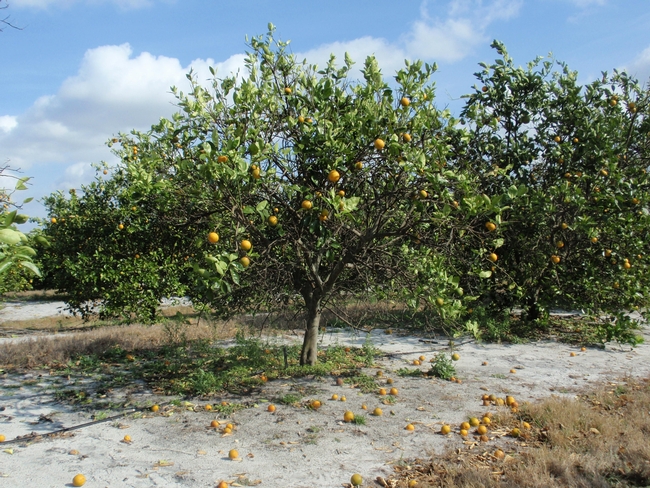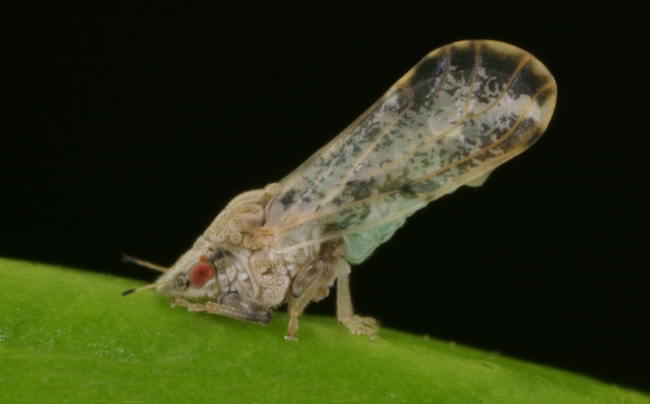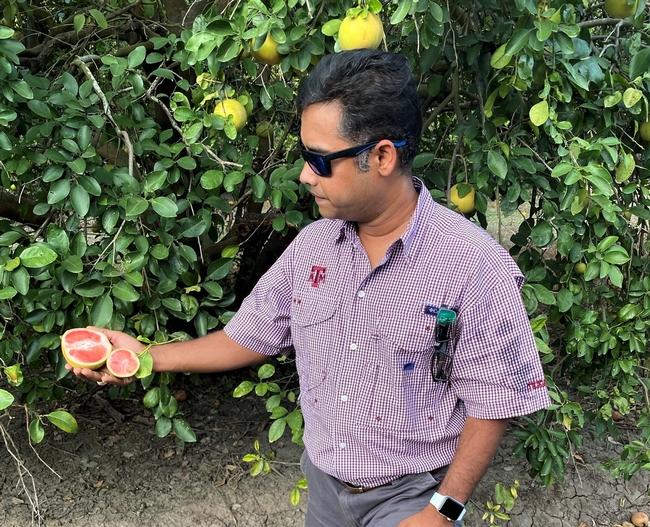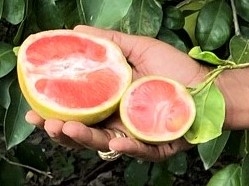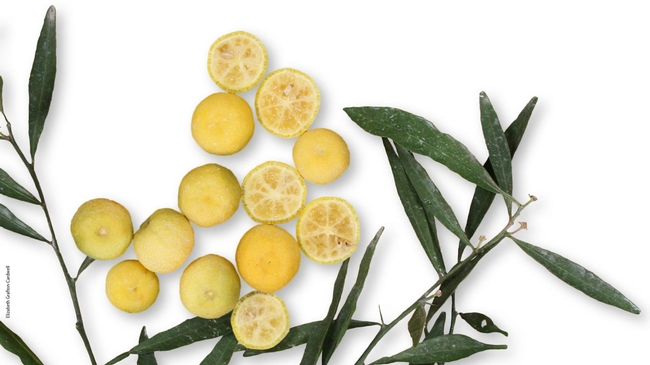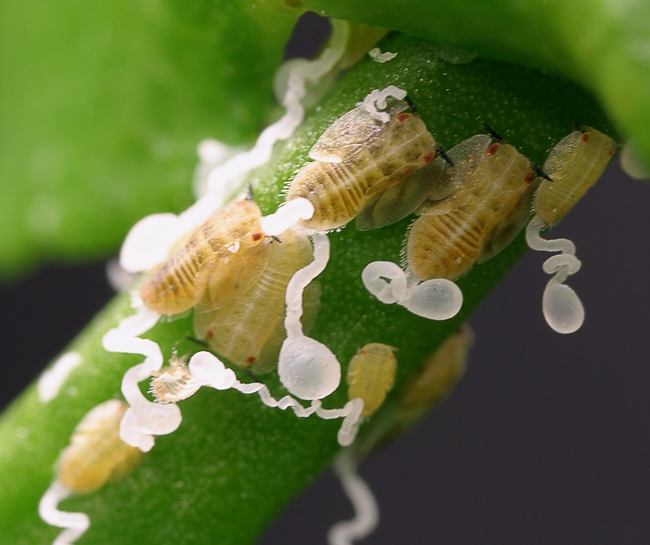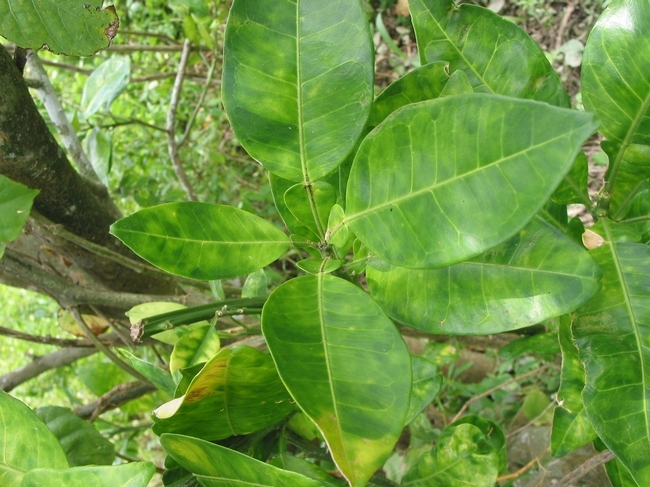Posts Tagged: HLB
Citrus threat target of $7 million multistate research project
UC ANR part of team led by Texas A&M AgriLife combating huanglongbing disease
Citrus greening, or huanglongbing disease (HLB), is the most devastating disease for orange and grapefruit trees in the U.S. Prevention and treatment methods have proven elusive, and a definitive cure does not exist.
Since HLB was detected in Florida in 2005, Florida's citrus production has fallen by 80%. Although there have been no HLB positive trees detected in commercial groves in California, more than 2,700 HLB positive trees have been detected on residential properties in the greater Los Angeles region.
“It is likely only a matter of time when the disease will spread to commercial fields, so our strategy in California is to try to eradicate the insect vector of the disease, Asian citrus psyllid,” said Greg Douhan, University of California Cooperative Extension citrus advisor for Tulare, Fresno and Madera counties.
Now, a public-private collaborative effort across Texas, California, Florida and Indiana will draw on prior successes in research and innovation to advance new, environmentally friendly and commercially viable control strategies for huanglongbing.
Led by scientists from Texas A&M AgriLife Research, the team includes three UC Agriculture and Natural Resources experts: Douhan; Sonia Rios, UCCE subtropical horticulture advisor for Riverside and San Diego counties; and Ben Faber, UCCE advisor for Ventura, Santa Barbara and San Luis Obispo counties.
$7 million USDA project
The $7 million, four-year AgriLife Research project is part of an $11 million suite of grants from the U.S. Department of Agriculture National Institute of Food and Agriculture, NIFA, to combat HLB. The coordinated agricultural project is also a NIFA Center of Excellence.
“Through multistate, interdisciplinary collaborations among universities, regulatory affairs consultants, state and federal agencies, and the citrus industry, we will pursue advanced testing and commercialization of promising therapies and extend outcomes to stakeholders,” said lead investigator Kranthi Mandadi, an AgriLife Research scientist at Weslaco and associate professor in the Department of Plant Pathology and Microbiology at the Texas A&M College of Agriculture and Life Sciences.
The UC ANR members of this collaboration will be responsible for sharing findings from the research with local citrus growers across Southern California, the desert region, the coastal region and the San Joaquin Valley.
“In addition to the ground-breaking research that will be taking place, this project will also help us continue to generate awareness and outreach and share the advancements taking place in the research that is currently being done to help protect California's citrus industry,” said Rios, the project's lead principal investigator in California.
Other institutions on the team include Texas A&M University-Kingsville Citrus Center, University of Florida, Southern Gardens Citrus, Purdue University and USDA Agricultural Research Service.
“This collaboration is an inspiring example of how research, industry, extension and outreach can create solutions that benefit everyone,” said Patrick J. Stover, vice chancellor of Texas A&M AgriLife, dean of the Texas A&M College of Agriculture and Life Sciences and director of Texas A&M AgriLife Research.
HLB solutions must overcome known challenges
An effective HLB treatment must avoid numerous pitfalls, Mandadi explained.
One major problem is getting a treatment to the infected inner parts of the tree. The disease-causing bacteria only infect a network of cells called the phloem, which distributes nutrients throughout a tree. Starved of nutrients, infected trees bear low-quality fruits and have shortened lifespans.
Treatments must reach the phloem to kill the bacteria. So, spraying treatments on leaves has little chance of success because citrus leaves' waxy coating usually prevents the treatments from penetrating.
Second, while the bacteria thrive in phloem, they do not grow in a petri dish. Until recently, scientists wishing to test treatments could only do so in living trees, in a slow and laborious process.
Third, orange and grapefruit trees are quite susceptible to the disease-causing bacteria and do not build immunity on their own. Strict quarantines are in place. Treatments must be tested in groves that are already infected.
Two types of potential HLB therapies will be tested using novel technologies
The teams will be working to advance two main types of treatment, employing technologies they've developed in the past to overcome the problems mentioned above.
First, a few years ago, Mandadi and his colleagues discovered a way to propagate the HLB-causing bacteria in the lab. This method involves growing the bacteria in tiny, root-like structures developed from infected trees. The team will use this so-called “hairy roots” method to screen treatments much faster than would be possible in citrus trees.
“Even though a particular peptide may have efficacy in the lab, we won't know if it will be expressed in sufficient levels in a tree and for enough time to kill the bacteria,” Mandadi said. “Viruses are smart, and sometimes they throw the peptide out. Field trials are crucial.”
The second type of treatment to undergo testing is synthetic or naturally occurring small molecules that may kill HLB-causing bacteria. Again, Mandadi's team will screen the molecules in hairy roots. A multistate team will further test the efficacy of the most promising molecules by injecting them into trunks of infected trees in the field.
A feasible HLB treatment is effective and profitable
Another hurdle to overcome is ensuring that growers and consumers accept the products the team develops.
“We have to convince producers that the use of therapies is profitable and consumers that the fruit from treated trees would be safe to eat,” Mandadi said.
Therefore, a multistate economics and marketing team will conduct studies to determine the extent of economic benefits to citrus growers. In addition, a multistate extension and outreach team will use diverse outlets to disseminate project information to stakeholders. This team will also survey growers to gauge how likely they are to try the treatments.
“The research team will be informed by those surveys,” Mandadi said. “We will also engage a project advisory board of representatives from academia, universities, state and federal agencies, industry, and growers. While we are doing the science, the advisory board will provide guidance on both the technical and practical aspects of the project.”
Project team members:
—Kranthi Mandadi, Texas A&M AgriLife Research.
—Mike Irey, Southern Gardens Citrus, Florida.
—Choaa El-Mohtar, University of Florida Institute of Food and Agricultural Sciences, Citrus Research and Education Center.
—Ray Yokomi, USDA-Agricultural Research Service, Parlier, California.
—Ute Albrecht, University of Florida IFAS Southwest Florida Research and Education Center.
—Veronica Ancona, Texas A&M University-Kingsville Citrus Center.
—Freddy Ibanez-Carrasco, Texas A&M AgriLife Research, Department of Entomology, Weslaco.
—Sonia Irigoyen, AgriLife Research, Texas A&M AgriLife Research and Extension Center at Weslaco.
—Ariel Singerman, University of Florida IFAS Citrus Research and Education Center.
—Jinha Jung, Purdue University, Indiana.
—Juan Enciso, Texas A&M AgriLife Research, Department of Biological and Agricultural Engineering, Weslaco.
—Samuel Zapata, Texas A&M AgriLife Extension, Department of Agricultural Economics, Weslaco.
—Olufemi Alabi, Texas A&M AgriLife Extension, Department of Plant Pathology and Microbiology, Weslaco.
—Sonia Rios, University of California Cooperative Extension, Riverside and San Diego counties.
—Ben Faber, University of California Cooperative Extension, Ventura, Santa Barbara and San Luis Obispo counties.
—Greg Douhan, University of California Cooperative Extension, Tulare, Fresno and Madera counties.
Three old trees might save the citrus industry
Three citrus trees that produce inedible fruit at the UC Lindcove Research and Extension Center in Visalia may be a game-changer for the citrus industry, reported Ezra David Romero on Valley Public Radio.
The trees are thought to be resistant to huanglongbing, a severe disease of citrus that has devastated the Florida industry and could become a serious problem in California. The citrus-saving potential of the three 34-year-old trees was outlined in an article by UC Agriculture and Natural Resources writer Hazel White in the most recent issue of California Agriculture journal.
UC Riverside citrus breeder Mikeal Roose collected seed from the trees and will test seedlings as soon as they are large enough.
"So what (breeders) have to do is cross this with some edible varieties and eventually create something that has the gene for resistance, but also the genes for good fruit," said Beth Grafton-Cardwell, Lindcove director and research entomologist.
Huanglongbing disease has cut citrus production in Florida by more than half. It's been found in residential citrus trees in Southern California, but hasn't reached the state's vast commercial orchards yet. Grafton-Cardwell said she expects the disease will arrive in 4 or 5 years.
New resource for growers and homeowners waging Asian citrus psyllid battle
Detailed and scientifically sound guidelines for treating farm- and home-grown citrus infested with Asian citrus psyllid are available on a new UC Cooperative Extension website, http://ucanr.edu/sites/acp.
The site’s launch coincides with the announcement last month by the California Department of Food and Agriculture that six more psyllids were found in three Tulare County yellow sticky traps. In 2012, three psyllids were found on two traps and an eradication program ensued.
The new website was developed by Beth Grafton-Cardwell and Matt Daugherty, UCCE specialists in the Department of Entomology at UC Riverside, Karen Jetter, economist with the UC Agricultural Issues Center, and Robert Johnson programmer with the UC Agriculture and Natural Resources Informatics and GIS Statewide Program program. Funding for the site was provided by UC Agriculture and Natural Resources.
The website includes information on the psyllid's distribution in California, monitoring methods and treatment options. For example, the website suggests citrus farmers and homeowners not rely on yellow stick card traps to monitor for the pest.
“At certain times of the year, the yellow sticky cards are totally unattractive to Asian citrus psyllid,” Grafton-Cardwell said. “The cards are just color, but citrus flush is an attractive color and also emits irresistible volatiles or smells.”
The website advises farmers to regularly conduct systematic visual surveys along the margins of their orchards looking carefully at new green shoots and conducting tap sampling. To tap sample, spray a plastic surface with soapy water, position the plastic sheet underneath a branch and tap the branch above to dislodge adult ACP. The insects will stick to the filmy plastic where they can be studied with a magnifying hand lens to determine if they are psyllids.
If psyllids are found, the UC website outlines the immediate action that is required.
Adult psyllids should be placed in a container with 90 percent alcohol and reported to the county agricultural commissioner’s office so the insects can be tested for huanglongbing disease. Immature stages of the pest should be left on the tree so the ag commissioner’s office can make an official regulatory collection.
“Florida and Texas don’t have exactly the same insecticides that are available in California and the environmental conditions are different,” Grafton-Cardwell said. “Over time we will compare different treatments and determine how long they will protect the trees. Any new developments will be posted to the website.”
Because the goal in the San Joaquin Valley is eradication, Grafton-Cardwell recommends aggressive action against a psyllid infestation.
“The best approach is using two broad-spectrum insecticides within a short period of time,” she said. “No one insecticide will kill all the stages of the pest."
Another key to successful eradication is area-wide treatment coordination. Grafton-Cardwell suggests farmers work closely with their treatment liaisons and treat their orchards in a coordinated manner.
“The bigger the area being sprayed at the same time, the better,” Grafton Cardwell said. “If we get a blanket effect over the whole area, that’s been shown in Florida and Texas to have the greatest impact on the psyllid populations.”
The aggressive psyllid treatment aims to buy time for researchers to find long-term strategies for maintaining the California citrus industry in the presence of ACP and, especially, with the incurable and fatal citrus disease they spread, huanglongbing.
Newly found Asian citrus psyllids prompt quick action in Tulare
After finding six Asian citrus psyllids (ACP) on three Tulare County yellow sticky traps last month, California scientists and officials are encouraging farmers to aggressively monitor and treat their orchards to prevent the sad fate befalling citrus farmers in Florida, where the pest and a serious disease it spreads are running rampant.
The July ACP find prompted the California Department of Food and Agriculture to quarantine 178 square miles in the Porterville area, placing severe restrictions on the movement of local citrus nursery stock and citrus fruit outside the area. It also prompted several hundred farmers and pest control advisers to gather July 30 at the International Agri-Center in Tulare for an update on the threat.
Like a scene from the film “Scared Straight,” Ken Keck, former executive director of the Florida Department of Citrus and now director of the California Citrus Research Board, admonished the California farmers to learn from the Sunshine State’s mistakes.
“I feel like the ex-con in front of a room of 17-year-olds,” Keck said. “All I can say is, ‘prevent, prevent, prevent.’”
Asian citrus psyllid is established in Southern California. Efforts in the southern part of the state are focused on managing the psyllids to reduce the likelihood they will find a tree infected with huanglongbing. Huanglongbing (HLB) is an incurable and fatal disease of citrus spread by ACP.
By working together and following science-based treatment strategies, UC Cooperative Extension specialist Beth Grafton-Cardwell believes farmers and CDFA can still eliminate ACP in the San Joaquin Valley, where the bulk of the state’s commercial citrus is grown.
At the Tulare meeting, Grafton-Cardwell explained the eradication strategy she developed by studying Asian citrus psyllid and huanglongbing disease management programs in Florida and Texas, another state where the pest is well established.
“We want to slow the spread of psyllid into new areas,” Grafton-Cardwell said. “We want to prevent psyllids from finding HLB infected trees.”
Although it is unlikely the pest and disease can be kept at bay indefinitely, Grafton-Cardwell said the battle will buy time for researchers to discover long-term approaches for maintaining California’s citrus industry in the presence of ACP and HLB.
Developing citrus varieties resistant to HLB through traditional breeding or genetic modification will take too long, she said. Scientists are considering such futuristic solutions as inserting HLB resistance into a mild form of the Tristeza virus and inoculating trees with the virus to fight HLB.
“Everyone is racing to come up with tactics to fight ACP and HLB,” she said. “I believe we will eventually be using multiple approaches, such as a repellent spray to keep ACP off the trees and perhaps breeding ACP that can’t transmit HLB and then flooding the population with these incapacitated psyllids.”
To fight ACP and HLB, growers and homeowners can access detailed information on the pest’s distribution, monitoring methods and treatment options on a new website created by Grafton-Cardwell with funding from UC Agriculture and Natural Resources.
|
For tap sampling, spray a plastic surface with |
The website advises farmers and homeowners to regularly conduct visual surveys and tap sampling (see video on right) in their orchards. “Yellow sticky card traps are not very attractive to psyllids,” it says.
If psyllids are found, immediate action is required.
Adult psyllids should be placed in a container with 90% alcohol and reported to the county agricultural commissioner’s office so the insect can be tested for HLB. Immature stages of the pest should be left on the tree so the ag commissioner’s office can make an official regulatory collection.
An ACP find should also trigger rapid and wide treatment with the most effective pesticides possible.
Micronutrient deficiency can look like HLB infection
Familiarity with symptoms caused by micronutrient deficiencies is important for citrus growers and pest control advisers to ensure such maladies are not confused with symptoms of Huanglongbing, reported Cary Blake in Western Farm Press.
Neil O’Connell, UC Cooperative Extension advisor in Tulare County, a citrus expert, recommends that field staff also be well versed on these issues since they are in the field daily during the citrus harvest.
Huanglongbing, a disease spread by Asian citrus psyllid, is the worst citrus disease in the world. The disease was detected on one tree in Southern California in March, the first such find in the state. Officials are asking for farmers and home gardeners to be on the look-out for other HLB-infected trees.
O'Connell says deficiencies of zinc, iron and manganese can resemble leaf symptoms found in trees with HLB.
"Some deficiencies have fairly similar symptoms," O'Connell said. "If you are very familiar with deficiency patterns in these elements then it is much easier to separate this out. You can recognize whether the problem is zinc, iron, manganese, or another deficiency while possibly ruling out HLB."
A distinguishing characteristic of HLB infection is a yellow area that crosses from one interveinal area to another, O'Connell explained.

